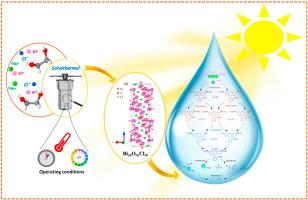Bi24O31Cl10的溶剂热合成参数优化:提高光催化性能、降解有机污染物的途径及机理
IF 4.9
3区 材料科学
Q2 CHEMISTRY, MULTIDISCIPLINARY
引用次数: 0
摘要
本研究旨在优化Bi24O31Cl10的合成参数,以提高其光催化降解水中染料的效率。采用不同温度(160℃、180℃、200℃)和不同次数(12 h、16 h、20 h)的溶剂热处理两步法合成Bi24O31Cl10颗粒,然后在500℃下热处理4 h,并考察了pH的影响。采用XRD、SEM、拉曼光谱、DRS和BET等方法对样品进行了表征,确定了样品的结构、形态和光学性质。最佳样品Bi24-160-12在160°C下合成12 h, pH不调节,在可见光下50 min内对罗丹明B的降解率达到99.98%。高效液相色谱(HPLC)和液相色谱-质谱(LC-MS)分析证实了分子分解通过逐步去乙基化和杂蒽环裂解,导致矿化成CO2和H2O。活性物种捕获实验强调了超氧自由基(∙O2−)和光生空穴(h+)在降解机制中的作用。Bi24-160-12表现出优异的稳定性,在多次循环中保持高效率,同时保持其晶体结构。此外,对其在紫外光下降解农药Imazalil的光催化性能进行了评价,证明了其在处理持久性有机污染物方面的通用性。这些发现强调了优化合成参数以提高材料性能的重要性,将Bi24O31Cl10定位为一种有前途的水处理光催化剂。本文章由计算机程序翻译,如有差异,请以英文原文为准。

Optimization of solvothermal synthesis parameters for Bi24O31Cl10: Enhanced photocatalytic performance, degradation pathways, and mechanism of organic pollutants
This study aims to optimize the synthesis parameters of Bi24O31Cl10 to enhance its photocatalytic efficiency for dyes degradation in aqueous media. Bi24O31Cl10 particles were synthesized through a two-step process: solvothermal treatment at varying temperatures (160 °C, 180 °C, 200 °C) and times (12 h, 16 h, 20 h), followed by thermal treatment at 500 °C for 4 h. The influence of pH was also examined. The samples, denoted as Bi24-T-t, were characterized using XRD, SEM, Raman spectroscopy, DRS, and BET analysis to determine their structural, morphological, and optical properties. The optimal sample, Bi24-160-12, synthesized at 160 °C for 12 h with unadjusted pH, achieved a remarkable 99.98 % degradation of Rhodamine B within 50 min under visible light. High-performance liquid chromatography (HPLC) and liquid chromatography-mass spectrometry (LC-MS) analyses confirmed molecular decomposition through progressive deethylation and xanthene ring cleavage, leading to mineralization into CO2 and H2O. Active species trapping experiments highlighted the roles of superoxide radicals (∙O2−) and photogenerated holes (h+) in the degradation mechanism. Bi24-160-12 exhibited excellent stability, maintaining high efficiency over multiple cycles while retaining its crystalline structure. Additionally, its photocatalytic performance was evaluated for the degradation of the pesticide Imazalil under UV light, demonstrating its versatility for treating persistent organic pollutants. These findings underscore the significance of optimizing synthesis parameters to enhance material properties, positioning Bi24O31Cl10 as a promising photocatalyst for water treatment applications.
求助全文
通过发布文献求助,成功后即可免费获取论文全文。
去求助
来源期刊
CiteScore
7.80
自引率
2.50%
发文量
605
审稿时长
40 days
期刊介绍:
The Journal of Physics and Chemistry of Solids is a well-established international medium for publication of archival research in condensed matter and materials sciences. Areas of interest broadly include experimental and theoretical research on electronic, magnetic, spectroscopic and structural properties as well as the statistical mechanics and thermodynamics of materials. The focus is on gaining physical and chemical insight into the properties and potential applications of condensed matter systems.
Within the broad scope of the journal, beyond regular contributions, the editors have identified submissions in the following areas of physics and chemistry of solids to be of special current interest to the journal:
Low-dimensional systems
Exotic states of quantum electron matter including topological phases
Energy conversion and storage
Interfaces, nanoparticles and catalysts.

 求助内容:
求助内容: 应助结果提醒方式:
应助结果提醒方式:


